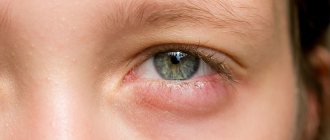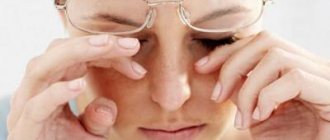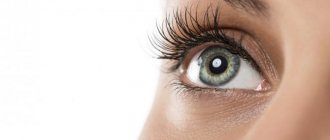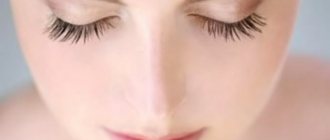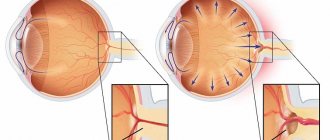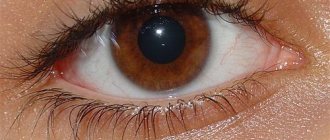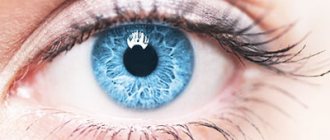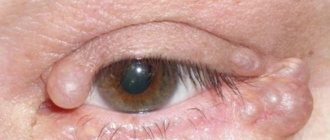Eyelashes are the main attribute of both female and male attractiveness. But their main function is to protect the eyes from mechanical damage and pollution. The life cycle of each eyelash is about 3 months. On the upper eyelid there are about two hundred of them and the length of each can reach 1.3 cm. The lower eyelashes are much shorter (up to 0.7 cm) and their number is half as much. In some cases, eyebrows and eyelashes begin to itch, discomfort, irritation, swelling, dryness and other unpleasant symptoms appear, which may indicate the presence of ophthalmological or dermatological diseases. Constant itching leads to the fact that a person rubs his eyes with his hands. This causes mechanical damage and hair breakage. Why does this happen and what should I do?
Reasons why eyelashes and eyebrows may itch
Itching can lead to a stressful state, no matter in which part of the body it bothers. Severe discomfort is accompanied by irritation at the base of the eyelashes. This symptom is alarming, but few people pay attention to it. If you ignore it and try to treat it on your own, serious consequences can occur.
What is the reason for itchy eyes?
- A stressful situation often provokes this phenomenon. Subsequently, active hair loss may begin.
- Barley. Itching develops several days before the appearance of suppuration and remains for a long period until the barley sac disappears.
- Demodecosis. A common cause of damage to the eyelid and base of eyelash growth is infection with scabies mites.
- Blepharitis. The inflammatory process develops along the edge of the eyelid and provokes increased mucus flow, redness, itching, peeling of the skin and loss of eyelashes.
- Allergic reaction to cosmetics, dust, food, etc. Accompanied by scabies and lacrimation.
- Conjunctivitis. Pain, pus, swelling, mucus, redness are familiar symptoms caused by this disease. It may be bacterial or viral in origin and requires appropriate treatment.
The specialist will conduct an examination, take tests and correctly determine the cause of your illness. The second step is to follow medical recommendations and treatment. Thanks to timely measures taken, you can quickly forget about your troubles and prevent complications.
So, we have familiarized ourselves with the entire list of culprits of itching; now let’s move on to a more specific study of each source of your discomfort.
Eyelash loss
Due to constant irritation of the skin on the eyelids, a person involuntarily rubs his eyes with his hands, which provokes breaks and mechanical damage to the hairs. After such manipulations, up to several dozen loose hairs may remain on the fingers and palms. The main factor in this phenomenon is the lack of vitamins in the body.
This situation cannot be corrected in a short time. To compensate for the deficiency, you will need to drink a complex of important minerals and vitamins for a long time. It is possible to apply externally special preparations with useful components to the problem area.
Allergy
Most likely it contains aggressive components and chemicals that are dangerous to the condition of the delicate skin of the eyelids. In addition, chemicals harm hairs, thin them and slow down the growth process.
If the problem goes away after removing the new cosmetics, congratulations. But if the itching still does not subside and hair loss begins, immediately seek qualified help from a medical facility. Trust the beauty and health of your eyes to doctors.
Stress
Prolonged nervous tension can cause thinning of eyelashes and cause discomfort. To maintain volume, try to put your nerves in order and regularly take soothing herbal teas and valerian tincture. As life's problems recede, the former splendor will return.
How the problem manifests itself
Allopathic remedies do not always help eliminate the root of the problem; often they only eliminate the symptoms. This is why many turn to homeopathy. Homeopathic medicines can make a person healthy and eliminate the source of problems. If you have the above symptoms, you can resort to the following remedies:
- (Lycopodium) – used at the initial stage of atopic dermatitis, when the eyelids just begin to turn red;
- (Pulsatilla) – used at the initial stage of atopic dermatitis, when the first flaky spots appear;
- (Aconitum) – for atopic dermatitis, accompanied by the appearance of flaky skin flakes;
- (Sulfur) – used for allergic rashes on the face, accompanied by scaly skin;
- (Alumina) – for scaliness, itching, cracks and dryness;
- (Calcarea Carbonica) – for dermatic dry crusts along the edges of the eyelashes, for peeling;
- (Arsenicum album) – for dermatitis, manifested in dry and flaky eyelid skin;
- (Graphites) – prescribed against formed cracks and flaking scales;
Asked by: Alina
Female gender
Age: 10
Chronic diseases: not specified
Hello! Not long ago, my eyelids started to itch after a shower. I didn’t attach any importance to it, combed it heartily and fell asleep. In the morning I discovered that the skin on the lower eyelid was cracked, stinging and itching. On the upper eyelids, at the inner edge of the eye under the eyebrows, there is peeling and redness. Plus, to all this, my eyes are constantly dry, I even had to buy a tear substitute.
Many people, including those who have vision problems, can live with keratitis for some time and experience almost no discomfort. But after a few months, and sometimes earlier, dry eye makes itself felt: the skin of the eyelids begins to hurt turns red and itches, eyelids are stuck together in the morning.
Added to these symptoms is a nagging headache. Staying in the heat, dusty or smoky air increases the problem.
Dangerous manifestations of pathology:
- severe pain and pain in the eyes;
- photophobia;
- decreased ability to see;
- prolonged redness of the skin of the eyelids and around them;
- redness of the eyeball.
What to do in such a situation: contact an ophthalmologist, otherwise vision may deteriorate irreversibly in the future, including due to damage to the cornea.
How to restore the normal state of the mucous membrane. Each eye treatment regimen is individual. If a patient buys drops without a doctor’s recommendation, then they must be used according to the instructions.
Reddened skin of the eyelids and dry eyes in a child are caused by both harmless reasons, for example, prolonged crying, and pathological conditions. Children's complaints about discomfort in the eyes should not be treated with disdain. Except for harmless reasons
, there are many congenital pathologies and genetic abnormalities in which the cornea suffers. Dangerous conditions are rare in medical practice, but vigilance does not hurt. The causes and treatment of pathology can vary dramatically: what is suitable for one child may harm another.
Typical conditions that cause dry eyes in a child:
- Allergy. In this case, dryness is accompanied by itching, redness, and burning. Some children have shortness of breath, cough, and runny nose.
- Infectious diseases. If pathogenic microorganisms enter the conjunctiva, the tear ducts become blocked, and this causes insufficient hydration of the cornea.
- Deformation of the eyelids as a result of trauma or congenital.
- Overload of the visual organs. This includes time spent playing games on the phone, at the computer, reading, studying, and in front of the TV.
- Felty and Schergen syndromes, oncology, autoimmune conditions, genetic pathologies.
We invite you to familiarize yourself with Rosacea on the face - causes in women, types and treatment
Important!
In any case, a child must first be shown to a doctor, who will tell you how to solve the problem - to cure the eyes quickly and without consequences.
Infectious and skin diseases
Unbearable itching and inflammation are two important signals about the presence of health problems. Do not ignore them, be sure to see a doctor. What diseases can cause discomfort?
Demodicosis
The mite has penetrated the hair follicles and sebaceous glands. As a result, the face turns red, an irritable reaction is observed, and the number of hairs falling out increases. This is direct evidence of active reproduction of the parasite. Ticks usually become active in the late afternoon. It is at this time that they actively reproduce and crawl out.
At first, a person unconsciously scratches his face, but later it becomes impossible to tolerate this feeling, rashes, ulcers, acne, ulcers, etc. appear. A sticky film appears on the eyelashes, which will periodically get into the eyes and spoil vision. To remove it, you need to wet the hairs with water.
Treatment is selected by a specialist and an individual regimen of pharmaceutical drugs is prescribed.
Blepharitis
The inflammatory process develops along the ciliary edge and is accompanied by scabies, a feeling of heaviness and swelling of the eyelid. The eyes quickly become tired, increased sensitivity to bright light appears, and hairs begin to grow abnormally and fall out.
To diagnose the disease, bacterial culture, visual acuity testing, and external eye examination are required.
Treatment is carried out comprehensively and is aimed at eliminating the symptoms and causes of the disease.
Conjunctivitis
There are different forms of inflammatory lesions of the conjunctiva. Burning, itching, lacrimation, and purulent discharge are often observed.
Treatment is predominantly local and involves the use of ointments, drops, subconjunctival injections and washing of the conjunctival sac.
Why do eyes with eyelash extensions itch?
Discomfort after the procedure can be caused by the following reasons:
- allergic reaction to glue components;
- microtrauma of the mucous membrane;
- irritation from adhesive fumes;
- inflammatory process as a result of infection.
If you encounter such an unpleasant situation, be sure to report the problem to the technician.
Itching, burning and other unpleasant symptoms are a serious signal to begin active action. If these sensations do not go away and you cannot independently determine the cause, then you need to contact a specialist to make a correct diagnosis. Do not attempt to self-medicate unless you are allergic.
Source: ProResnitsy.ru
Description of the eyelash mite and its reproduction
Demodexes are small arachnids, the size of which is no more than 0.2-0.5 mm. Their lifestyle takes place entirely in the sebaceous and sweat glands of the human body (see photo of an eyelash mite), i.e. Demodexes are human symbionts. These creatures can be permanent inhabitants of the skin without causing any harm, that is, they are in a neutral or opportunistic form of their development. Demodex's favorite habitat is human eyelids and eyelashes.
Under unfavorable circumstances for humans (deterioration of immunity, hypothermia, changes in hormone levels, etc.), interciliary mites transform into a pathogenic form and begin to multiply greatly, which causes an unpleasant disease - demodicosis.
During the breeding season, female eyelash mites lay eggs directly into the hair follicles near the eyes. After 60 hours, the larvae hatch from them, which do not even know how to move, but are only able to feed for 40 hours and grow. Their next stage is their transformation into a nymph that lives exclusively on hair follicles.
The main diet of demodex mites on eyelashes at all stages of development is dead epidermal cells and sebum (therefore, parasites often choose people with oily skin), which is not at all dangerous for humans. However, waste products of eyelash mites, which appear in large quantities during mass reproduction of parasites, often become strong allergens that provoke a negative reaction in the human body.
Food, animal, or environmental allergies
Itchy eyes are most often a hallmark of allergies. This condition is also called allergic conjunctivitis . Basically, it is a minor reaction to certain allergens - food or environment. Unfortunately, you may also be allergic to eyelash extensions , or rather to the glue that is used during the procedure. Even your pets can cause itchy eyes!
Taking over-the-counter antihistamines or using eye drops may help calm the allergic reaction and relieve itching.
Dry eyes
Dry eye syndrome , a condition in which a person does not produce enough quality tears to moisturize and nourish the eye, is a common and often chronic problem, especially in older people. Unlike some other causes of itchy eyelashes , dry eyes are a chronic condition and require specific treatment.
Using artificial tears and anti-red eye drops can help moisten the eyes and relieve itching.
Irritants
Some chemicals or ingredients in personal care products can lead to contact dermatitis , an irritating and itchy skin rash. This can lead to flaking of the skin, especially around the eyelid. Eye dermatitis can be caused by other irritants, but makeup and skin care products are the most common culprits that make you want to constantly touch your eyelashes. Switching to hypoallergenic cosmetics, especially those that you apply directly under your eyes, can be a good way to combat itching.
How to deal with eyelash loss using traditional methods
Dehydrated and tired eyelashes need special care, which can be done with the help of vegetable oils.
If you notice that your eyelashes are falling out, then make this nourishing mask : castor, olive and linseed oils are mixed in equal proportions. Then you need to take a clean brush and apply the resulting mixture to the eyelashes, evenly distributing it from roots to ends, massaging a little with the brush, moving it from side to side. You can add a little vitamin E to the oils, which promotes more active blood circulation and the growth of new healthy eyelashes.
Another option is to also use green tea compresses . You need to brew green tea, dip cotton swabs into the cooled strong brew and place them on your eyes for 20-30 minutes. With the help of such lotions, not only the eyelashes are nourished, but also relieves irritation from the skin of the eyes.
When wondering why eyelashes fall out, you should pay attention to the sufficiency of their nutrition. If you work in an office, you may encounter such a common phenomenon as impaired blood microcirculation. It is a consequence of low levels of physical activity, as well as constant work at the computer. To relieve fatigue and improve nutrition of hair follicles, try massaging your eyelids every evening .
Follow the following massage technique:
- The temple area and inner corners of the eyes are massaged in a circular motion; repeat 10 times.
- Lightly pressing the skin of the lower eyelid with your fingertips, perform movements in the direction from the outer corner of the eye to the inner. The exercise must be repeated for the upper eyelid.
- Using the pads of the middle and index fingers, it is necessary to make clockwise movements in a circular motion, moving from the lower eyelid to the upper, repeat 8-10 times.
- Perform tapping movements with the pads of your middle and index fingers, moving from the outer corner of the eye to the inner.
- With your eyes closed, perform light pressing movements on the upper eyelid and do several repetitions.
Before you start the massage, apply a night nourishing cream or oil to your eyelids. When doing exercises in the morning, supplement them with a contrast wash, it helps to harden the blood vessels.
Inflammation of the eyelids
The medical term for this disease is blepharitis . The most common causes of blepharitis are staph bacteria, scalp dandruff, and conditions such as rosacea . Blepharitis primarily affects the eyeballs, causing itching, redness, increased tearing, swelling, and dryness. Often flakes, similar to dandruff, form where eyelashes grow, and of course cause a constant desire to rub your eyes. In more serious cases, blepharitis can lead to blurred vision, inflammation of the eye tissue (especially the cornea), or complete loss of eyelashes.
Eye-strain
We live in the age of digital technology, and, perhaps, we can no longer imagine our life without smartphones, tablets, and laptops. But our “mirror of the soul” is not at all happy with this. Constant digital eye strain can cause fatigue, headaches, difficulty focusing, and potentially affect your vision in the long term. Of course, this is accompanied by such phenomena as itching of eyelashes and eyelids . So the next time you have a strong urge to rub your eyes, first just take a little break from gadgets.
What else should you do if your eyelashes are falling out a lot?
- Eliminate allergens.
Take a responsible approach to choosing cosmetic products, including decorative cosmetics. Be sure to pay attention to the composition and expiration dates. If you are a fan of eyelash extensions, carefully choose a specialist and ask what materials he uses when working.
- Give your eyelashes a rest.
Eyelashes need to be given a rest from time to time. While on vacation, for example, try not to use decorative cosmetics. If you can’t imagine yourself without makeup, use eyeliner rather than mascara. By drawing a thin, neat arrow, you will give your eyes expressiveness, without having any effect on the eyelashes that are not yet fully strengthened.
- Makeup removal is everything to us.
Forget about the habit of going to bed without removing your makeup. To remove cosmetics, it is better to use mild products based on oils for sensitive skin. Avoid soap, as it dries the skin, disturbing its acid-base balance.
- Balance your diet.
Make sure your diet is balanced and complete. Eating fresh fruits and vegetables, animal proteins, seeds, grains and vegetable oils should become your daily habit. At the same time, give up fast food and sweets. They contain practically no nutrients, but they do not have the best effect on the digestive system.
Something got in my eye
Foreign objects entering the eye can cause itching, irritation and pain. Whether it's a grain of sand, an eyelash, or anything else, before vigorously rubbing your eyelids, think about the harm it could cause to your eyes. One of my friends was so irritated by an eyelash that got into her eye that, in an attempt to get it out, she tore out half of her normally growing eyelashes, and then with all this “beauty” she came to me for extensions. So if you think something has gotten into your eye, the first thing to do is try rinsing it with water or artificial tears (plain eye drops without any additional chemicals).
Why do women's eyelashes fall out?
Let's take a closer look at why women's eyelashes fall out and what to do in this case. In addition to those listed above, hair loss occurs in women for special reasons. For example, almost every girl uses cosmetics that allow her to emphasize her external attractiveness. If we talk about the beauty of the eyes, then the fair sex uses mascara, eyeliner, and shadows. And here the quality of cosmetics and the absence of allergic reactions play a significant role. If you notice that after using a new (or, conversely, too old) mascara, your eyelashes have begun to thin, take a closer look at it. It doesn’t matter whether the expiration date has passed or the product itself is simply of poor quality, refuse to use it without regret.
Why might hair, eyelashes and eyebrows start to fall out during pregnancy? This is caused by hormonal changes occurring in the body, as well as the increased need for vitamins and minerals, which during this period are needed not only by the woman herself, but also by the unborn child. If you are pregnant and notice that the condition of your eyelashes has worsened, first of all, you should reconsider your diet, perhaps additionally turning to vitamin supplements. In general, the exact cause of eyelash loss can only be determined by a doctor.
Using contact lenses
If you wear contact lenses , you may experience itching or a burning sensation in the eyelash area. This is due to the fact that long-term use of lenses further dries out the eyes. Also, allergens can accumulate in lenses, thereby aggravating symptoms. Some people may also develop a contact lens allergy called giant papillary conjunctivitis . And of course, simply washing your eyes with water is not enough here.
Contact your doctor as soon as possible if you experience frequent or persistent itching of the edge of your eyelids or eyelashes. After all, to determine the best treatment, an accurate diagnosis is necessary.
I hope my information was useful to you. Be healthy and beautiful! ?
Source: pilochka.ua
Allergy
The reason that the eye itches, where the eyelashes grow, in most cases is an allergy. Increased sensitivity of the body to various substances can cause a negative reaction of the immune system. Most often, allergies occur during the period of active flowering of plants. Other symptoms of the disease include:
- redness of the mucous membrane;
- eyes are very watery;
- in some cases, the face becomes swollen and nasal discharge appears.
To treat allergic conjunctivitis, antihistamines based on cetirizine, levocetirizine, loratadine, fexofenadine (Tigofast, Cetrin, Cetrilev, Lorano) are used once a day.
To eliminate redness of the eyes, use antiallergic drops based on dexamethasone or sodium cromoglycate (Kromofarm).
Cosmetic products for restoring eyelashes after loss
Are you wondering why eyelashes fall out and what to do about it? The modern market offers a wide selection of various cosmetics that can cope with the problem of eyelash loss.
The choice of one or another remedy should be approached individually. However, it is worth familiarizing yourself with the general principles that can guide you when purchasing cosmetics:
- The best are drugs containing tocopherol and retinol. With their help, the structure of the hairs is restored, the metabolism in the hair follicles is normalized, and, accordingly, eyelash loss is prevented.
- Also pay attention to the presence of castor oil in the composition of the products. It has long been considered one of the most effective means for caring for eyelashes.
- Gels containing vitamin C and keratin will help protect your eyelashes.
Remember that you can buy a high-quality cosmetic product to cope with the problem of eyelash loss at a pharmacy or specialty store.
Barley
If the eyelid itches near the eyelashes, this may indicate a disease such as stye. It is an inflammation of the fatty gland or hair follicle of the eyelash caused by infection. Most often, the cause of barley is staphylococcus or streptococcus. Its occurrence is influenced by factors such as failure to comply with personal hygiene rules, hypothermia, stress, and being in a contaminated room.
Symptoms of stye include:
- itching and burning in the eyelash area;
- increasing swelling;
- a capsule that forms on the edge of the eyelid containing pus inside;
- after opening it, a crust appears in this place.
Treatment of the disease is carried out using ointments containing antibiotics (Tetracycline, Tobradex) which are applied to the inflamed area 3 - 4 times a day. Antibiotic eye drops (Floxal, Cipropharm) are also used.
Preventive actions
In order to avoid the appearance of these parasites on eyelashes, it is important to adhere to the necessary preventive measures:
- Never use someone else’s cosmetics, personal hygiene products, clothes, or underwear;
- If there are pets in the house, they should be checked by a veterinarian for the presence of eyelash mites;
- If you are outside the home, use only disposable sanitary napkins;
- Be sure to keep your immunity at a high level, take vitamins from time to time;
- Avoid stressful situations;
- Monitor the state of your digestive system.
Demodicosis on the eyelashes is an unpleasant disease that brings great discomfort. If left untreated, unpleasant symptoms can be a constant concern, and over time they will only intensify. Therefore, it is important to begin its treatment as early as possible. In addition, during treatment therapy you must strictly follow all recommendations. It is precisely the strict fulfillment of all the requirements of therapy that will help to completely get rid of this disease.
Demodicosis
Another reason why eyes itch and eyelashes fall out is demodicosis. This disease is caused by mites from the Demodex group, which parasitize the skin. The disease is transmitted by contact and the tick does not cause any symptoms in a healthy person. In people with weakened immune systems, the parasite can cause problems such as:
- sticking together of eyelashes, the appearance on them of a thin sticky film similar to mucus;
- eyelash loss;
- itching in the corners of the eyes;
- fatigue and dry eyes;
- inflammation of the eyelids
To treat demodicosis, eyelid lotion Stop Demodex or Demodex Active gel are used. The product is applied to the affected area 2 – 3 times a day.
Why do men's eyelashes fall out?
Let's figure out why eyelashes fall out in men. Among the main reasons are:
- poor nutrition;
- stressful situations;
- presence of bad habits;
- use of certain household chemicals;
- eye disease or inflammation (possibly due to prolonged computer use);
- the occurrence of hormonal disorders;
- taking a number of medications.
Having noticed more severe eyelash loss than usual, men first need to reconsider their diet, completely eliminating the consumption of fast food and processed foods and adding more vegetables and fruits containing vitamins to the daily menu. You should also give up bad habits, replacing them with healthy sleep. If these methods do not help, then you should seek advice from a specialist who can determine the cause of eyelash loss and prescribe appropriate treatment.
Blepharitis
The upper eyelid in the eyelash area may itch with blepharitis. This is a common infectious disease, the causative agent of which can be bacteria, viruses, fungi or protozoan microorganisms. With blepharitis, a person experiences the following symptoms:
- small pustules appear in the follicles, which eventually open, forming marginal ulcers;
- this causes pain;
- dense crusts form in place of the pustules, and after their removal a bleeding surface remains;
- during sleep, eyelashes become sticky with purulent discharge;
- If treatment is not started in time, scarring and eyelash loss may occur.
Signs of appearance
Before you begin treatment for demodex of the eyelids and eyelashes, it is worth finding out the main symptoms that characterize the presence of this unpleasant guest on the eyelashes.
The first symptoms of demodex may include the following unpleasant conditions:
- The appearance of redness of the white membrane of the eyes;
- Eyelashes often itch at the base;
- Over time, eyelashes begin to fall out;
- The appearance of discharge from the eyes with a sticky structure;
- Along the edges of the eyelids, the skin begins to peel off;
- Swelling of the eyelids.
All these symptoms lead to damage to the mucous layer of the eyes, it acquires a dry structure, increased irritability occurs, and rapid eye fatigue appears. At the very first stage of the appearance of eyelash mites, there may be severe itching of the eyes.
In addition, during demodicosis the following unpleasant conditions may appear:
- Decreased vision;
- Frequent occurrence of stye;
- There may be a feeling of sand in the eyes;
- Fear of bright light.
In the area of the eyelids, this disease is determined by the presence of plaque along the edges of the eyelids, as well as by sticky eyelashes, which are surrounded by a membrane. Demodex is often accompanied by acne.
In addition, you can easily become infected with Demodex, because the mite from a sick person is easily transmitted to the eyelashes of a healthy person.
Conjunctivitis
The cause of irritation can be inflammation of the conjunctiva of the eyes caused by the ingress of pathogenic microorganisms. In this case, a person experiences the following symptoms:
- pain, itching and burning in the eye area;
- redness of the conjunctiva;
- lacrimation;
- purulent discharge.
Treatment is carried out depending on the causative agent of the disease; antibiotics or antiviral drugs are used in the form of eye drops. They are used 2–4 times a day according to the instructions. Treatment lasts until the symptoms of the disease disappear completely.
